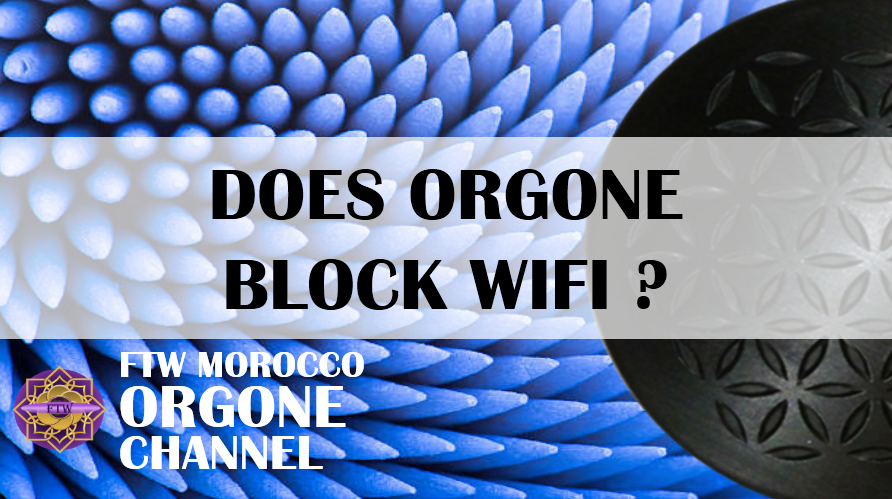Orgone Energy The Fountain Of Youth
This experiment was one we had to really search for in order to find! It was conducted by Despina Malkotsi who is in charge of ‘Heraclitus’ Microscopic Research Laboratory. Under strict scientific procedures, the experiment calls for a laboratory examination to verify or refute the claim that orgone energizes a person’s red blood cells, thus preserving their vital state longer than in ambient conditions. This blood test, called the “Reich Blood Test” or RBT can detect biopathic situations that are active in the organism without arriving to a specific diagnosis. The RBT is based on the direct observation of the blood immediately after its extraction from the body’s vessels, and without biochemical processing.
According to Dr. Reich, as soon as the red blood cells leave the blood vessels, they begin disintegrating into cysts (the decay process begins). Reich called these cysts ‘bions.’ He observed that bions pulsated and were motile. Intriguingly, in healthy organisms they gave off an intense blue light. Classic Biology also describes bions as characteristic protrusions of the cell membrane. This phenomenon was called ‘bebbling.’
Dr. Reich recognized a very primitive and undifferentiated stage of the living state in bions. This is described in detail in his book ‘The Bion Experiments.’ Numerous such experiments were conducted in Oslo between 1936 and 1939, where he showed the disintegration of living and non-living matter, and the subsequent organization of bions in formations manifesting characteristics of living and functioning.
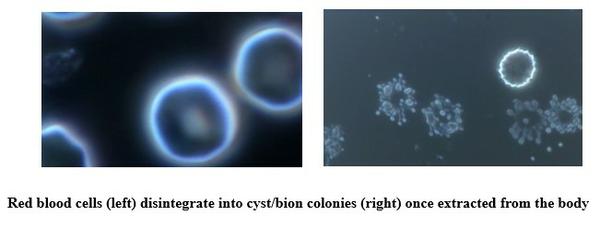
- an orgone accumulator (ORAC), 3-layer per side, measuring 35 x 35 x 35 cm
- a ‘control’ box of similar dimensions, made of wood.
- A 3-layer orgone blanket
- a small metal box
- a laboratory microscope (Zeiss Axioskop 2)
They used a magnification of 1600x initially, but when there was a need for a more detailed observation of the sample, they increased the magnification to 4000x.
The blood used in the test was taken from the capillaries of the volunteer in sterile conditions. The blood was then mixed with saline solution at a ratio of 1:40, and then the team prepared two slides each containing the blood sample from the same person. The team’s main concern was to obtain the red blood cells in their natural condition. If the red bloods cell were destroyed, the samples were considered unsuitable.
Next, one slide was placed in the ORAC for 15 minutes. It was first placed in the small metal box then wrapped in the orgone blanket that was inside the ORAC. The second blood sample was placed in the wooden control box. The two samples were then microscopically examined successively, at the same time. They observed the processes occurring in both samples during their death and ongoing decay (into cysts/bions).
Every 5 minutes the team observed and recorded the following characteristics of the red blood cells (erythrocytes): vigor, pulse and motility, width of energy field, rate of disintegration into bions, bion size and distribution in the inner part of the cell disk. The goal of the examination was to find differences in the two samples as regards to the erythrocytes’ characteristics mentioned above. In this way, they determined the effects of the different conditions existing in the two boxes on the red blood cells. The two samples were thus checked successively at the same time and recorded.
In the following images, the ORAC sample is on the left and the control is on the right
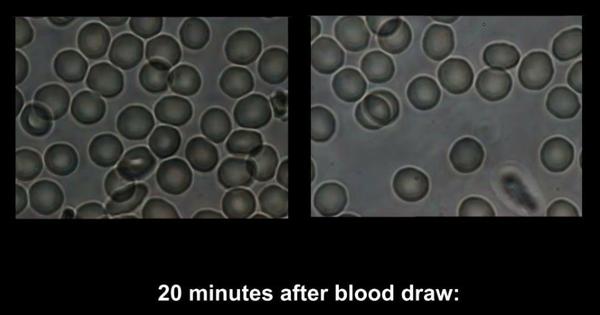
Both samples still show motility and pulse. The red blood cells kept in the control box show loose membranes and amount of disintegration is 2-3%. The amount of disintegration for the red blood cells kept in the ORAC is about 1%
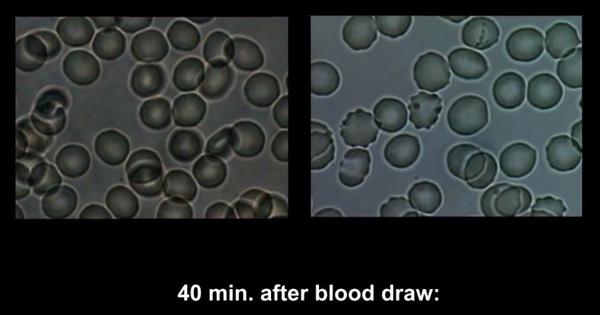
The red blood cells kept in the control box still show pulsation, but most of them are immobile and the percentage of disintegration is 2-8%. The red blood cells kept in the accumulator continue to show motility and pulsation, and their disintegration is 2-3%.
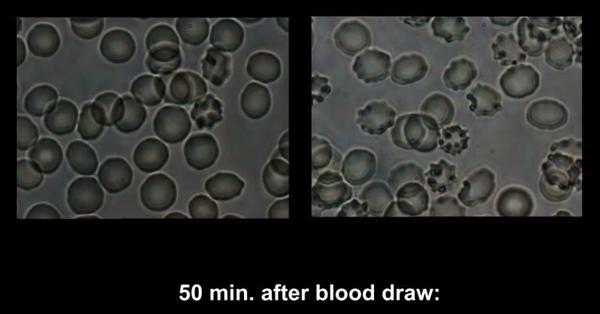
The differences between the two samples examined are even more obvious. The red blood cells kept in the control box show a disintegration of 40-50%, while the ones in the ORAC of only 5%.
Conclusion of RBT Replication
From the findings of the microscopic examination of the two samples, the Dr. Despina’s team observed the following:
- The red blood cells kept in the accumulator showed motility for longer time.
- Their disintegration into bions was slower.
- Their membrane tension was also preserved for a longer time.
The above findings as well as more data were collected during the examination. Blood cell samples of 10 individuals, for 4 times each, at different weather conditions were tested. The team also observed:
- The red blood cells kept in the accumulator showed more motility at a rate of about 60-70%.
- The rate of disintegration into bions/cysts was slower by 70% and the bions’ size was larger at a rate of about 90%.
- It was also observed that when the humidity of the environment was high, the differences of the quality characteristics of the red blood cells in the two boxes were greatly smaller.
In summary they stated, “In conclusion, we can say that the orgone accumulator has a clear biological effect on the blood examined with the method of the Reich Blood Test, improving the vigor of the red blood cells.”
We thank the laboratory research team at Heraclitus Microscopic Research Laboratory for this ground-breaking research!
Naima will be sending you another email that shows how you can use orgone energy to energize your food and water!
Till Next time,
-Tivon
Fix the World







